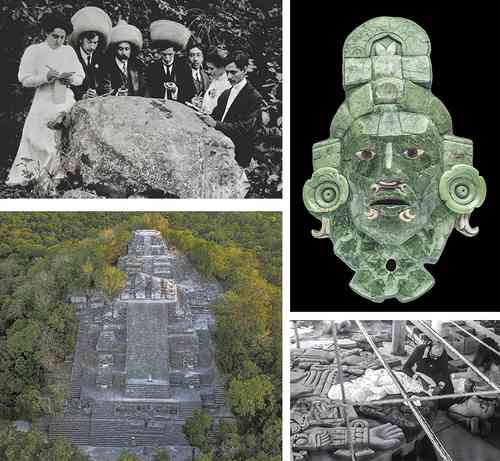INAH, 85 years old provides a collective vision of the institute as a guardian of identity
▲ As usual, archaeology students during a field practice s/f; then, Calakmul mask, made of jade, an essential component of these elements used by the Mayan sovereigns. Also, panoramic view of the archaeological zone of Calakmul, Campeche, captured in 2023, and moment of the discovery of the monolith of Coyolxauhqui, Mexica goddess of the Moon, in 1978. All of these are part of the exhibition INAH, 85 years: Guardian of our memory, which will remain until the end of September.Photo courtesy of INAH
An immersion in time, geography, communities and the historical, cultural and artistic assets of Mexico is proposed by the photographic exhibition INAH, 85 years: GGuardian of our memory, in the Open Gallery Reforma-Aquarium of the Rejas of Chapultepec Forest.
Comprising 82 large-format images, it offers an overview of the different facets of the Institute’s work, through the lens of distinguished photographers, most of whom are collaborators of that institution, who create a collective vision of the country’s immense tangible and intangible heritage, as well as the complex and exciting work that this department carries out through its employees.
Likewise, it represents A worthy recognition of a leading and fundamental institution of the Mexican State
and a well-deserved tribute to the workers who have made the study, research, protection, dissemination, teaching and social enjoyment of cultural heritage a life mission, said Diego Prieto, general director of INAH.
Through historical photographs of archaeological sites, historical monuments, ethnic groups, museums and cultural assets, as well as some moments linked to characters, activities, customs, celebrations and knowledge of the native peoples, we seek that the thousands of spectators who daily have contact with the Galería Acuario del Bosque de Chapultepec recognize and marvel at this diverse cultural framework and this wonderful institution that is the INAH.
held.
Snapshots are also displayed that refer to very specific tasks, processes and moments. For example, he mentioned those that refer to the ethnographic or restoration work carried out by the institute’s schools, as well as archaeological rescue, the safeguarding of collections or the restoration of buildings affected by the earthquakes of September 2017.
Regarding this last item, he reported that during the current administration, the INAH has contributed to the recovery of more than 3 thousand historic properties.
The exhibition also includes photos of some of the 15,000 pre-Hispanic, historical and cultural assets that have been recovered and repatriated during this six-year term in the context of the federal government’s campaign My Heritage Is Not For Sale, after having been illegally removed from the country.
▲ Cacaxtla murals discovered by residents of San Miguel del Milagro, Tlaxcala, in 1975. Later, discovery of the colossal head known as Monument 1 or The King, of San Lorenzo Tenochtitlan.Photo by Melitón Tapia and courtesy of INAH
Among them, Diego Prieto mentioned the imposing monolith called the Portal of the Underworld or Monster of the Earth, from Chalcatzingo, Morelos, which was illegally removed from Mexico half a century ago and which after long political, legal and diplomatic negotiations was repatriated last year.
Open to the public until the end of September, INAH, 85 years: Guardian of our memory This is a fascinating and instructive journey that allows us to get to know the first Mexican archaeologist, Isabel Ramírez Castañeda (1881-1943), who is seen during a day of field work in an image from the beginning of the last century. It also provides an insight into indigenous communities in contemporary Mexico and their ancestral practices and customs.
What can we say about the possibility of marvelling at the shots of impressive areas such as Uxmal, Tulum, Paquimé or Kabah, or the discovery of dinosaur bones, petroglyphs on the edge of a beach, a quartz arrowhead in the desert or a vestige in the depths of one of the national oceans, in addition to the snapshots of dozens of pre-Hispanic pieces of magnificent beauty.
The exhibition is part of the celebrations for the eight and a half decades of the INAH, Through these, it has established itself as the great Mexican institution dedicated to studying, preserving, protecting, recovering, disseminating and promoting the social enjoyment of Mexico’s inexhaustible cultural heritage, in addition to training professionals in anthropology, history and the disciplines concerned with the care and exhibition of the nation’s cultural assets.
according to its director.
The role of the INAH has undoubtedly been substantial in forging an idea of homeland, sovereignty and national identity, as a basis for the unity of the nation, but also in recognizing the innumerable identities that forge this multicultural nation, whose condition is originally based on its indigenous peoples, as stated in the second article of the Political Constitution.
